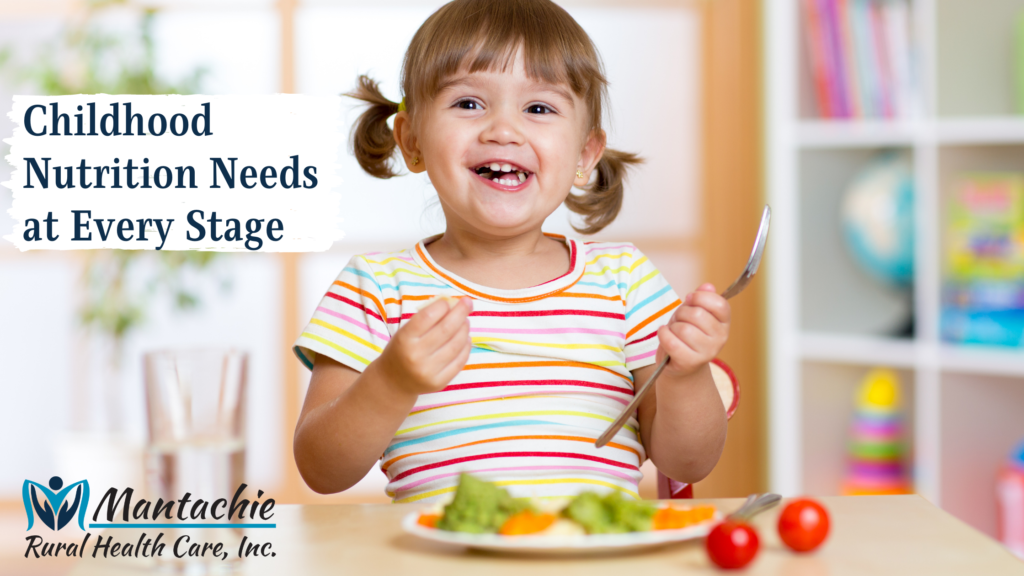
According to healthychildren.org, one in three children in the United States are obese. In addition to a preference for screen time over physical activity, children’s diets are playing a major role in childhood obesity. Today, we’re taking a look at childhood nutrition needs at every stage.
Filling your child’s tummy and preventing hunger isn’t the goal for your child’s diet. Their diet should also provide proper nutrition and healthy ingredients to help your child reach their milestones.
Infants and Toddlers
Got milk? Breastmilk or formula provides just about every nutrient an infant needs during their first year of life. However, breastmilk may not provide enough iron and zinc in infants ages six to nine months. At six months, infants are ready to start adding solid foods to their diet. Fortified cereals and meat can provide the iron and zine infants are missing from breastmilk.
A key thing to know about toddlers and eating is that their appetites come and go in spurts, just as toddlers are growing in spurts at this age. It’s completely normal for a toddler to want to eat everything in sight one day and to eat like a bird the next day. It’s important to make each meal and snack count nutritionally at this stage. Two nutrients to provide are calcium and fiber.
Preschool and Lower Elementary
Calcium and fiber are two key nutrients your child needs at the preschool stage. At this age, kids become more defiant about what they will and won’t eat. They turn to foods like chicken nuggets and mac n cheese as their favorites while fruits and vegetables become less preferred. Despite this, feeding your preschoolers enough fruits and vegetables is vital to their health and developmental growth. Add a serving of fruits or veggies to each of your child’s meals and choose at least one healthy snack a day. Go for easy to eat, colorful veggies like carrots and fibrous, nutrient-dense fruits like apples and berries.
Your healthy eating efforts with your children may stall when they become elementary school students. Cakes, candy and other less nutritious options are often available with school lunches and you won’t be there to swap their chocolate cake with a serving of mixed berries. One way to combat the school lunch is to pack your child’s lunch from home. This way, you still have control over what they are eating and can ensure they are getting a nutritious, healthy, well-rounded meal. If its necessary for your child to eat school lunches, be sure they are getting the nutrients they need in the meals you serve at home.
As children interact with others, they’ll develop their own ideas of what a healthy diet looks like. Some of these ideas may last a day, others may last a lifetime. For instance, your child may go through a vegetarian phase when they learn the sad side of how we get meat. Protein is a key nutrient at all stages of life, and you may have concerns that a vegetarian diet won’t give your child everything they need. However, foods like lentils and peanut butter are full of protein! If your child wants to try a new diet, learn everything you can about it so you can help your child make good choices about their food.
Preteens and Teens
Ah, the puberty stages. Also known as the stages every parent secretly fears. Our children’s bodies undergo major changes, and they need more calories during puberty to keep up. However, many preteens and teens, particularly girls, will start worrying about their weight and take steps to restrict their caloric intake. Boys often have the opposite thoughts and want to take in more calories to gain weight. Unfortunately, both boys and girls make unhealthy eating choices at these stages.
One way to encourage your teens and preteens to eat healthily is to teach them facts about diets such as why their caloric intake is so important and how they can get those calories in a healthy way. Your teens and preteens may be tempted to fill up empty stomachs with junk food but you can discourage this by limiting the amount of junk food in your kitchen and increasing the amount of fruits and vegetables and other healthier options like nuts.
Caloric intake isn’t the only important thing to consider with your preteen or teen’s diet. Other nutrients like calcium become even more vital at this stage because their bodies and bones are growing so quickly. Replacing certain nutrients also depends on your child’s gender. Girls, for instance, will need to replace the iron they lose during menstrual cycles to avoid becoming anemic. Boys need a bit more protein than girls to help them stay at a healthy weight and increase muscle mass. Keep these things in mind as you teach your kids about healthy eating.
Are you concerned about your child’s diet? If they are struggling to meet physical milestones and always seem to be a bit underweight, it’s time to get help from a nutrition specialist. Our dietitian, Erica Witcher, RDN, CDCES can assess your child and help you develop a plan to get them on the right nutritional track. Click here to request an appointment.

